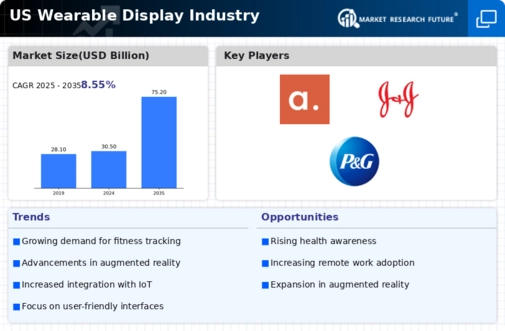Rising Demand for Fitness Tracking
The increasing focus on health and fitness among consumers is driving the wearable display market. As individuals seek to monitor their physical activity, heart rate, and other health metrics, devices equipped with advanced display features are becoming essential. In the US, the fitness tracker segment alone is projected to grow at a CAGR of approximately 15% from 2025 to 2030. This trend indicates a robust demand for wearable displays that can provide real-time feedback and insights. The wearable display market is thus witnessing a surge in innovation, with manufacturers integrating sophisticated sensors and user-friendly interfaces to cater to this growing consumer base.
Increased Adoption of Smart Wearables
The proliferation of smart wearables, including smartwatches and augmented reality glasses, is a key driver for the wearable display market. As consumers increasingly integrate these devices into their daily lives, the demand for multifunctional displays is rising. In the US, the smart wearable segment is anticipated to grow by over 20% annually through 2027. This growth suggests that consumers are looking for devices that not only track health metrics but also provide notifications, navigation, and entertainment. The wearable display market is responding by developing products that combine various functionalities into a single device, thereby enhancing user convenience.
Consumer Preference for Seamless Connectivity
The demand for seamless connectivity among devices is shaping the wearable display market. As consumers seek to integrate their wearables with smartphones and other smart devices, the need for compatible and user-friendly displays is becoming paramount. In the US, approximately 70% of wearable device users report a preference for products that offer easy connectivity with their existing technology. This trend suggests that the wearable display market must prioritize interoperability and user experience in their designs. Manufacturers are likely to focus on creating displays that facilitate smooth interactions across multiple devices, enhancing the overall functionality and appeal of wearable technology.
Technological Advancements in Display Technology
Innovations in display technology are significantly impacting the wearable display market. The introduction of OLED and microLED technologies has enhanced the visual quality and energy efficiency of wearable devices. These advancements allow for thinner, lighter, and more vibrant displays, which are crucial for user engagement. In the US, the market for advanced display technologies is expected to reach $10 billion by 2026, reflecting a growing interest in high-quality visual experiences. The wearable display market is adapting to these changes, as manufacturers strive to incorporate cutting-edge display solutions that enhance functionality and user satisfaction.
Growing Interest in Augmented Reality Applications
The wearable display market is experiencing a notable shift due to the rising interest in augmented reality (AR) applications. Industries such as gaming, education, and retail are increasingly adopting AR technologies, which require advanced display capabilities. In the US, the AR market is projected to reach $50 billion by 2028, indicating a substantial opportunity for wearable devices that can deliver immersive experiences. The wearable display market is likely to benefit from this trend, as manufacturers explore ways to integrate AR features into their products, thereby attracting a broader audience and enhancing user engagement.













Leave a Comment